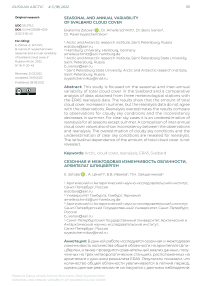Seasonal and annual variability of Svalbard cloud cover
Автор: Zotova Ekaterina, Schmitt Amelie, Ivanov Boris, Svyaschennikov Pavel
Журнал: Российская Арктика @russian-arctic
Статья в выпуске: 18, 2022 года.
Бесплатный доступ
This study is focused on the seasonal and inter-annual variability of total cloud cover in the Svalbard and a comparative analysis of data obtained from three meteorological stations with the ERA5 reanalysis data. The results show that the amount of total cloud cover increases in summer, but the reanalysis data do not agree with the observations. Reanalysis overestimates the results compare to observations for cloudy sky conditions and the inconsistency decreases in summer. For clear sky cases it is an underestimation of reanalysis for all seasons except summer. A comparison of inter-annual cloud cover values also show inconsistency between the observations and reanalysis. The overestimation of cloudy sky conditions and the underestimation of clear sky conditions are revealed for reanalysis. The latitudinal dependence of the amount of total cloud cover is not revealed.
Arctic, cloud cover, reanalysis, svalbard
Короткий адрес: https://sciup.org/170196175
IDR: 170196175 | УДК: 551.576.2 | DOI: 10.24412/2658-42552022-3-30-43
Текст научной статьи Seasonal and annual variability of Svalbard cloud cover
Arctic climate is known to change relatively dramatically compared to other regions [1]. The Arctic amplification is a phenomenon which is known as the increase of warming velocity in the Arctic compared to the rest of planet [2]. This phenomenon is caused due to a combination of a general background warming [3], anomalies in the atmospheric circulation [4], reduced sea ice extent and higher sea surface temperatures [5] and increased water vapour [6] which lead to the change in cloud conditions [7]. Considering the importance of clouds in the Arctic, the cloud cover plays significant role in the Arctic climate system and can influence the ocean-atmosphere and land-atmosphere energy exchange [8]. It is important to know the time and location of clouds. However, it is difficult to obtain cloud cover data in the Arctic. Clouds in the Arctic are mostly optically thin and low-lying [9], and they have a low contrast with the underlying surface [10], which makes them hard to be observed from satellite mostly in winter [11]. Recent studies have shown that the net cloud radiative forcing in the Arctic is positive [12]. The increasing of clouds may cause strong positive feedback leading to an increase of surface temperature [13]. Clouds are also one of the main factors determining the transfer of short-wave and long-wave radiation. Their effect on radiation fluxes is determined by the amount, height, thickness and water content of clouds [14].
There are several investigations of cloud cover distribution in the Arctic which are focused on average values of cloud cover of the entire Arctic or on the point measurement on different areas or with different methods of measuring.
Chernokulsky and Esau [12] have been investigating the Eurasian Arctic cloud cover using the data from 89 meteorological stations from the Barents Sea to the Chukchi Sea from 1936 to 2012 years. An annual cycle with the minimum of total cloud cover in February-March and the maximum in September–October was determined. The total cloud cover was smaller during the cold period (1960–1980).
Eastman and Warren [15] compared the results of total cloud cover from surface and remote observations of entire Arctic from 1971 to 2009 years. The investigations of seasonal cycle showed the differences in cloud cover distribution with minimum in April and December and maximum in September according to surface observations. However, the satellite observations showed the dramatic decrease of total cloud cover in April and maximum in June—July.
Maturilli and Ebell [16] processed data collected by laser ceilometer for the detection of cloud base height since August 1992 in Ny-Ålesund, Svalbard. The seasonal distribution of total amount of clouds was found. The extended summer season which was found to be from May to September revealed the lowest occurrence of clear-sky conditions, and is consequently the most cloud-covered period of the year. This article makes it possible to compare the results of visual observations with the instrumental measurements. The general patterns in seasonal cloud cover distribution are also consensual. Unfortunately, due to the inhomogeneous time series given in mentioned article [16] it is impossible to compare the inter-annual variability of instrumental and visual observations on Ny-Alesund station.
The reanalysis data are one of the main data sources for evaluating the climate change in Arctic [17]. However, it is needed to estimate the quality of data provided by reanalysis. The investigations for inter-comparison of observations and reanalyses are studied in current work.
Naud et al. [18] compared the cloud cover observations in Southern Ocean taken from Moderate Resolution Imaging Spectroradiometer (MODIS) and Multi-angle Imaging Spectroradiometer (MISR) to ERA-Interim and MERRA reanalyses. The results showed the difficulties in producing the right amount of clouds in the Southern Ocean. Cloud cover in cyclonic environments was underestimated in the ERA-Interim and MERRA reanalyses. The MERRA cloud cover bias was larger than that of ERA-Interim.
Walsh and Chapman [19] studied the associations between cloud cover, radiative fluxes and surface air temperature in the central Arctic using observations of drifting ice stations and atmospheric reanalyses of the National Centers for Environmental Prediction (NCEP) - NCEP-NCAR Reanalysis 1 and the European Centre for Medium-Range Weather Forecasts (ECMWF) – ERA5. The NCEP reanalysis exaggerated slightly the association between cloudiness and surface air temperature, while the ECMWF reanalysis showed a considerably weaker association. The NCEP cloud fractions were nearly identical in summer and winter while the ECMWF distribution showed a strong bimodality (either no clouds or complete overcast) during winter and a preponderance of overcast or near-overcast during summer.
Alexander Chernokulsky and Igor I. Mokhov [11] investigated total cloud cover in Arctic and compared the results of surface and satellite observations with reanalysis data. The investigation showed that different observations for total cloud fraction were in a better agreement in summer than in winter and over the ocean than over land. An inter-annual variability was higher in winter than in summer according to all observations. Generally, reanalyses are not in a close agreement with satellite and surface observations of cloudiness in Arctic.
The main aim of this study is to find out the general patterns and features of cloud characteristics of Svalbard and to compare the results of observations with the reanalysis. So that, several questions occurred. How does cloud cover change with seasons? Does the cloud cover have a tendency to change within the last decades? Is the reanalysis data in accordance with observations? From that, this study defines seasonal and annual features of cloud distribution for the entire Svalbard using data of three meteorological stations.
These sources of data were chosen due to several reasons. All three stations have relatively long time series and latitudinal character of stations distribution makes it possible to compare the patterns of cloud cover distribution of southern and northern parts of Svalbard.
Investigating the seasonal distribution of cloud cover the summer season is considered to reveal the highest amount of cloudy sky. The current investigation is done for the area of Svalbard; however, the consensual results are provided for the entire Arctic. The results of current work do not show the complete concordance of reanalysis and observations neither for seasonal distribution, nor for inter-annual variability as at the study of Walsh and Chapman [19]. The results are better agreed in summer season and for clear sky conditions.
Materials and methods
In order to find out the long-term variability of cloud cover frequency the data from meteorological stations “Barentsburg”, “Hornsund” and “Ny-Alesund” were taken. The total cloud cover data were obtained visually. The description of data taken from meteorological stations under consideration is provided in table 1.
In order to get representative data series an equal time period from 1983 to 2018 were taken for analysis for all studied stations and reanalysis.
The location of all stations is shown on figure 1.
ERA5 reanalysis [23] was taken to compare with observations obtained from studied stations. It provides hourly estimates for a large number of atmospheric, ocean-wave and land-surface quantities. The data have been regridded to a regular lat-lon grid of 0.25 degrees.
Fraction of cloud cover is the proportion of a grid box covered by cloud (liquid or ice) and varies between zero and one. The hourly data 1 on single levels from 1979 to 2020 were used for analysis.
All collected data were converted from octas into points. Several gaps in time series occurred. In order to avoid the uncertainties with the data gaps the data were converted into a percentage of total amounts of all cases and divided into five gradations from 0-1 points to 9-10 points. All calculations and obtaining ERA5 data were done via Python 3.7.
1 ERA5 reanalysis data: !/dataset/reanalysis-era5-single-levels?tab=overview. Retrieved on 03.06.2021
Table 1 Observational data description
|
Station: |
Barentsburg1 |
Hornsund2 |
Ny-Alesund3 |
|
Coordinates |
78°04′N, 14°13′E |
77°00′N, 15°33′E |
78°94′N, 11°89′E |
|
Location |
Grønfjorden at 74 m a.s.l. at the western part of Svalbard |
Hornsundfjord in the South-West of Svalbard |
Kongesfjorden at the Western shore of Svalbard |
|
Available data |
from 1966 to 2019 |
from 1983 to 2018 |
from 1969 to 2020 |
|
Measurements per day |
UTC 00:00, 03:00, 06:00, 09:00, 12:00, 15:00, 18:00, 21:00 |
UTC 00:00, 03:00, 06:00, 09:00, 12:00, 15:00, 18:00, 21:00 |
UTC 6:00, 12:00, 18:00 |
|
Units |
Points (0 — 10) |
Octas (0 — 8) |
Octas (0 — 8) |
1 Data source (retrieved on 25.10.2020).
3 Data source:
(retrieved on 17.05.2021).
To investigate the inter-annual variation of clear and cloudy sky conditions and to determine the trend lines a linear regression analysis was done. Significance of regression was tested according to [24].
Results: monthly distribution of total cloud cover
To estimate seasonal variability of cloud cover the distribution functions for all months were built. One of the most important features of cloud cover is the discrepancy of total cloud cover frequency to normal distribution. In winter season the distribution has U-type shape and it is the bimodal beta-distribution. It is changing into J-type distribution in summer season which is shown on the figure 2. The character of distribution found gives an opportunity to distinguish the seasons of study area with summer (July-September) and winter (December-March) seasons, as well as spring (April-June) and autumn (October-November) seasons as the transition periods. The classification of seasons given will be used during the current study.
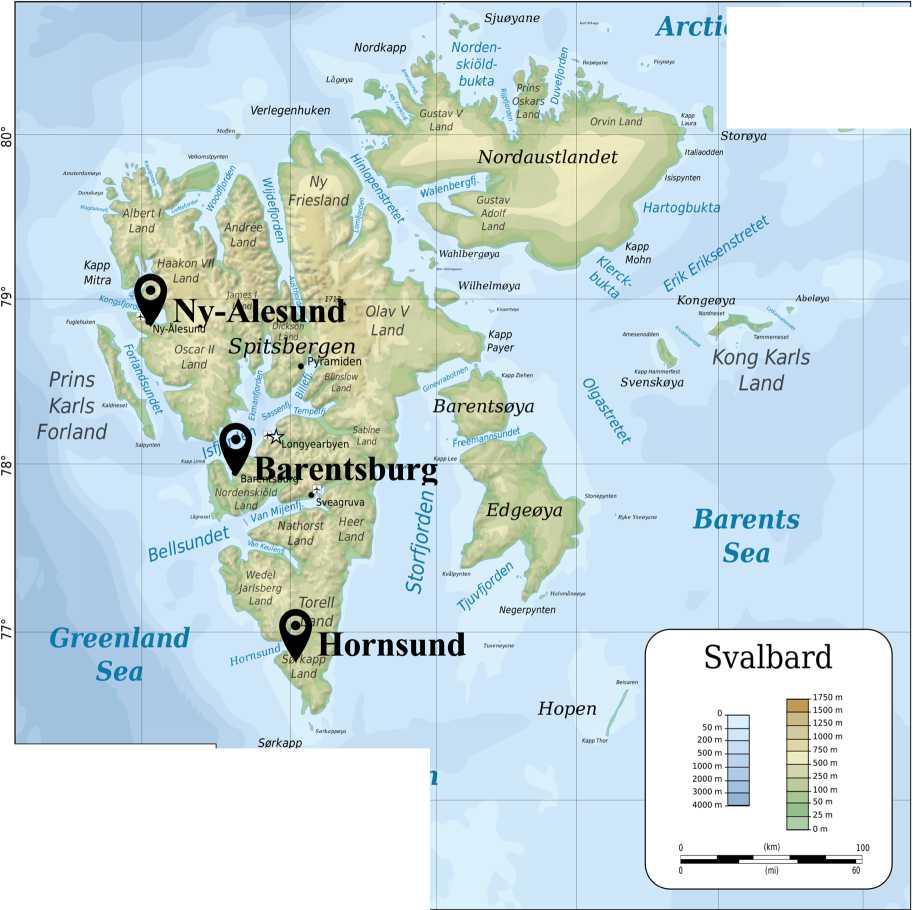
Friesland
' Wahlbergoya
Haakon VM
Barentsoya
Temp^j
.ongyearbyen
Nordenskipld
Andree
Wedel ,'Jarlsberg
Oskars Q i tand^j
Freeman^
rNy-Alesurra
Oscar II Land
Sveagruva cithorst Heer land Land
Alesund olavv
°™" Land
Spitsbergen e Pyramiden vs Biinslow
Alberti
Arctic Ocean
Nordkapp
Lageya
Verlegenhuken
Orvin Land
Nordaustlandet
Hartogbuktci
Wilhelmoya
Abeleya
Svenskoya
Karls
Forland
Edgeoya
Negerpynten
^re^n,and ^^.Hornsund зеа
Svalbard
Hopen
Sorkapp lUStav V
Kapp Mitra
Norden-skiold-। bukta
Kongeoya
Kong Karls Land
Prins
Barents Sea
, Gustav
Adolf
। Land
/f> Mohn
Storoya
Italiaodden
Kvitoya
Bjornoya
Fig. 1. Layout of meteorological stations on Svalbard (based on WikimediaCommons, 2020 1 )
Norwegian Sea
1 WikimediaCommons (2020). File: Topographic map of https://upload.wikimedia org/wikipedia/commons/0/00/ Retrieved on 30.08.2021
According to Fig. 2, prevalence of cloudy sky conditions is found for each month for each meteorological station. The summer season is the cloudiest season — over 60% cloudy sky cases are detected in Hornsund station. Other stations show lower percentage of cloudy sky cases than Hornsund but, nevertheless, the highest values in comparison to other months. Moreover, the percentage of clear sky is pretty high in winter season compared to the other seasons. The differences in clear and cloudy sky cases in autumn and spring seasons have similar tendency of cloud cover distribution: around 20% of clear sky cases and around 45% of cloudy sky cases.
Hornsund station which is known to be the most southern station considered shows the highest values of cloudy sky cases for all months. The exceptions are in August and October. The results are 7-10% higher than the other stations values in average. The percentage of clear sky cases is the lowest for all months.
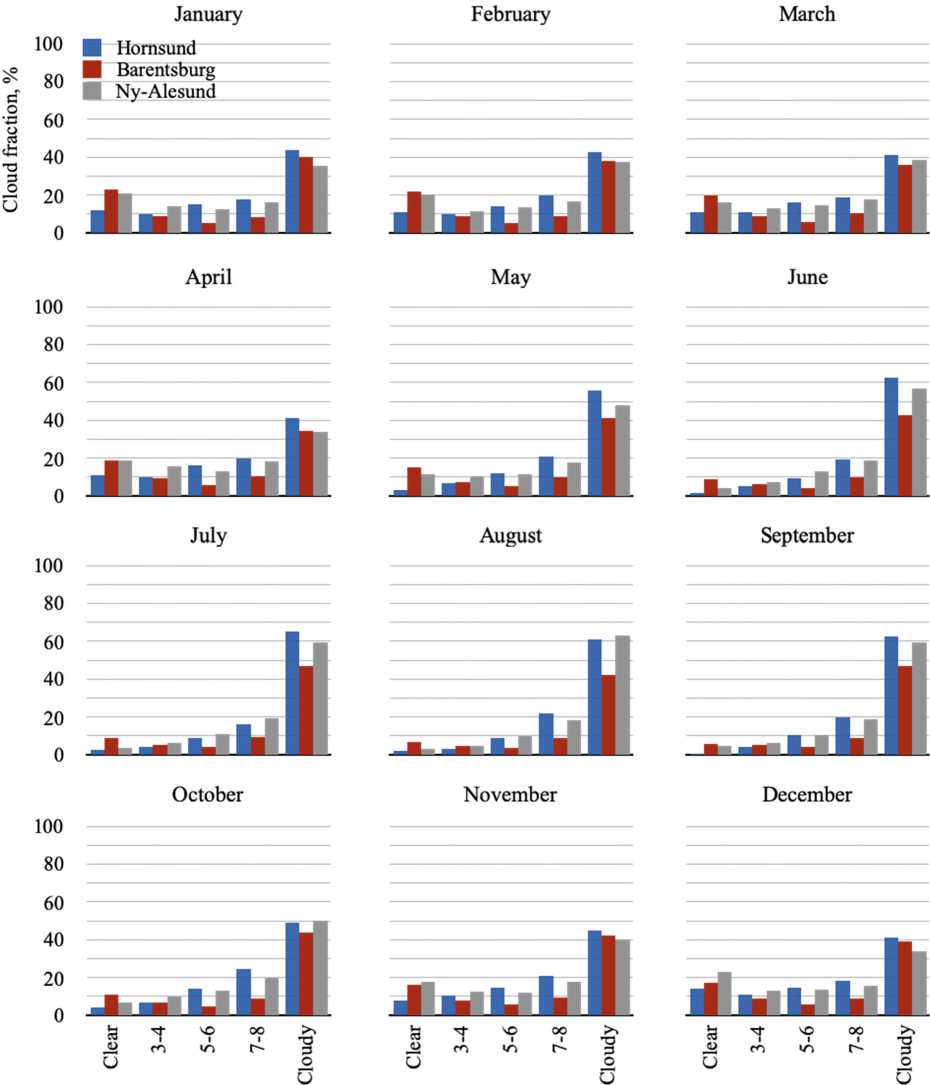
Fig. 2. Monthly long-term average values of total cloud cover of Hornsund, Ny-Alesund, Barentsburg (1983-2018)
In contrast, Barentsburg station has the lowest values of cloudy sky cases for spring, summer and autumn season. The exception is in April, when the percentage of cloudy sky of Barentsburg and Ny-Alesund data are the same. In Autumn-Winter season (November-February) the percentage of Barentsburg cloudy sky cases 3-5% higher than Ny-Alesund results but still lower than Hornsund case. The number of clear sky cases is the highest for all months except December; however, the inequality is not significant.
Ny-Alesund station is the most northern station considered, however, it does not show the opposite results to Hornsund station. It can be related to local microclimatic features of stations location e.g., relief characteristics and influence of glaciers location.
To compare the character of cloud cover distribution for observations and reanalysis monthly long-term average values of ERA5 reanalysis are visualized on fig. 3.
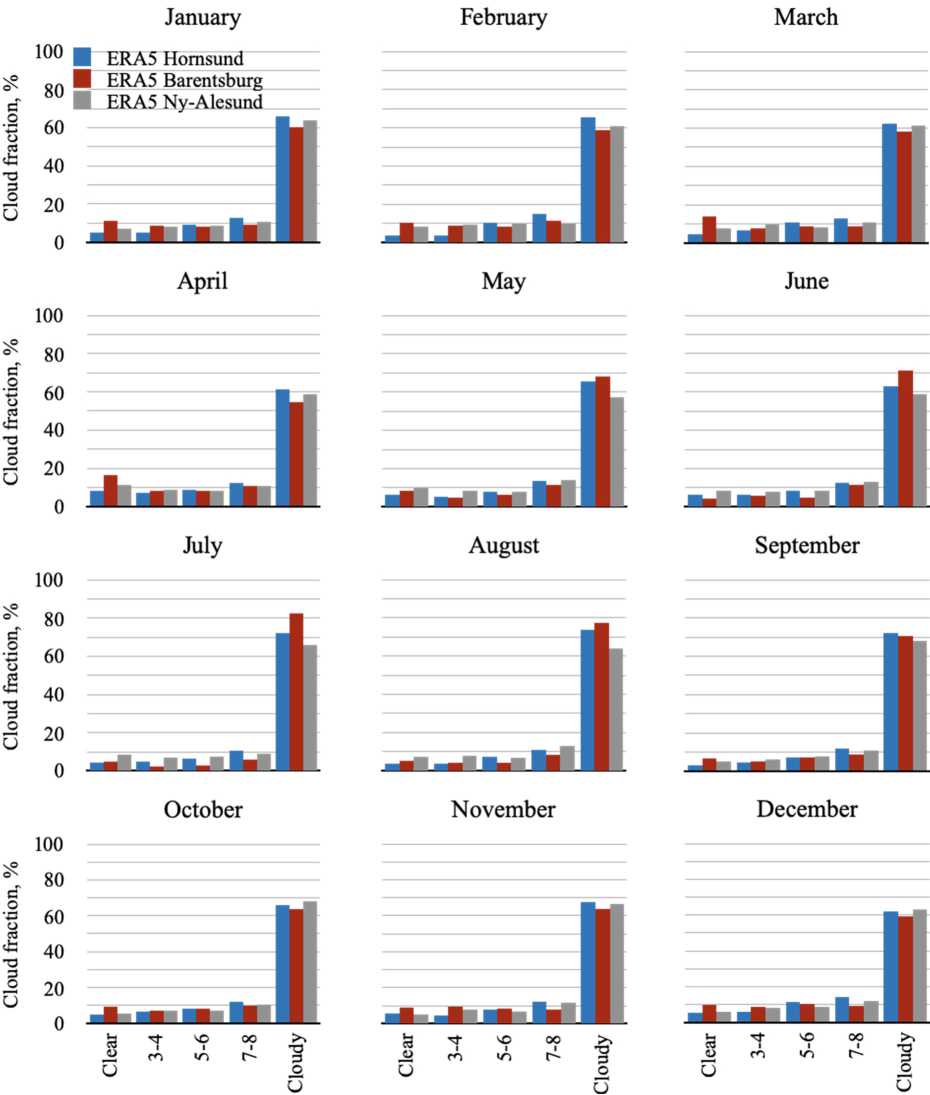
Fig. 3. Monthly long-term average values of total cloud cover of ERA5
The nearest to stations grid cells is taken to make representative comparison. The character of distribution is the bimodal beta-distribution; however, it has J-type shape for all seasons and the differences between lowest and highest values are more significant for ERA5 data than for observations. The nearest to Hornsund grid cell which is known to be the most southern point is appeared to have the highest amount of cloudy sky cases only in winter season — from November to April. In summer season the cloudiest grid cell considered is the nearest to Barentsburg station. October has the predominance of cloudy sky cases near the Hornsund station. As for clear sky cases, the predominance of those in autumn-winter season is appeared in nearest to Barentsburg grid cell, and for summer season the highest values of clear sky cases are found in nearest to Ny-Alesund grid cell.
These results are not consistent with visual observations. Therefore, it is needed to make detailed analysis of observations and reanalysis data.
Figures 2 and 3 show the dramatic change of clear sky cases (0-2 points) and cloudy sky cases (9-10 points) from season to season but the other values of cloud cover (from 3 to 8 points) do not really change. So that the clear sky cases and cloudy sky cases is taken for detailed analysis.
The seasonal distribution of clear and cloudy sky frequency is investigated in the following by taking the long-term monthly average values from observations and reanalysis data. The nearest to each station ERA5 grid cells are taken in order to get a spatially representative comparison. The equal time period is chosen according to available time series – from 1983 to 2018. The frequencies of clear and cloudy sky conditions have inverse relations for all three pairs “station — reanalysis”. The features of relations are analyzed in detail (fig. 4).
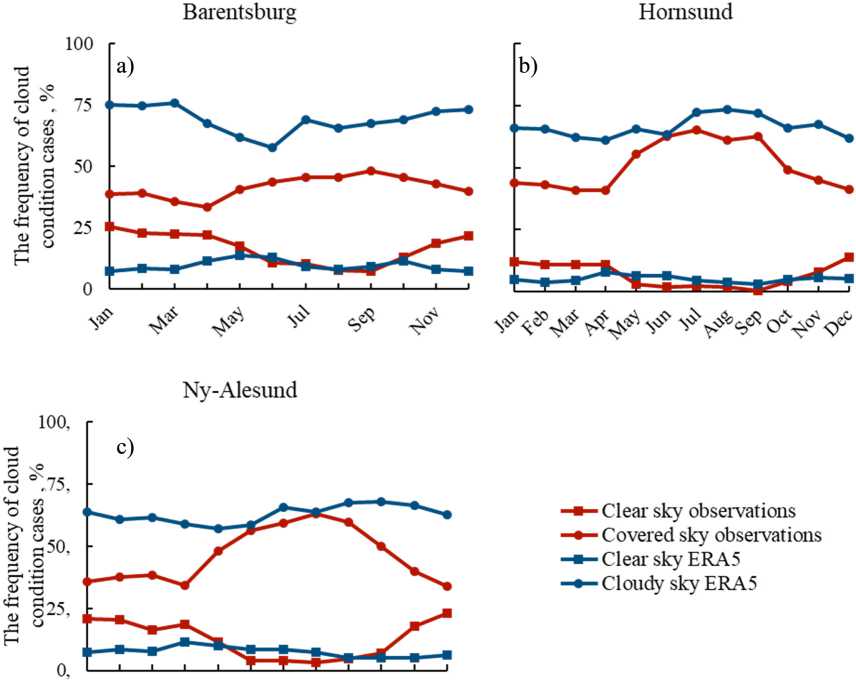
^^^ ^^ ^ ^^^ о*^^
Fig. 4. Long-term monthly average values of clear and cloudy sky frequencies a) Barentsburg; b) Hornsund; c) Ny-Alesund
The nearest to Barentsburg ERA5 grid cell is appeared to be 78º 50’ N/ 12º 00’ (fig. 4 a). The inconsistency of clear and cloudy sky conditions relation is shown to appear in January-February. The distribution of cloudy sky does not change for both station and ERA5 data while clear sky distribution shows decrease of station data compare to reanalysis data. The lowest percentage of cloudy sky is detected in April what corresponds to spring season and the highest percentage of cloudy sky is fixed in August-September which corresponds to summer season. However, the differences between in-situ data and reanalysis are quite perceptible. In average, the percentage of cloudy sky cases of reanalysis is 1,5 times higher than station data. The frequency of clear sky cases according to reanalysis has a tendency to increase in spring season which does not match station data.
The nearest to Hornsund grid cell is appeared to be 77º 00’ N/ 15º 00’ E (fig. 4 b). The increase of cloudy sky cases in spring-summer season is more intense than the decrease of clear sky cases in the same time period. The lowest percentage of cloudy sky is detected in April what corresponds to spring season and the highest percentage of covered sky is fixed in July which corresponds to summer season. Reanalysis data shows higher values. June is known to be the only month with consensual results of station and reanalysis data. According to station data, the clear sky case has a tendency to decrease in spring season which does not match reanalysis data.
The comparison of the results of Barentsburg and Hornsund data shows the decrease of differences between reanalysis and station data in case of Hornsund. In case of clear sky, Hornsund has only 2% of difference between station and reanalysis in average while Barentsburg difference is 6% in average. In case of cloudy sky, 28% of difference is estimated in Barentsburg case while only 15% of difference is estimated in case of Hornsund.
The seasonal distribution of clear and cloudy sky frequency of Ny-Alesund and nearest ERA5 grid cell (790 00’ N/ 120 00’ E) is shown on figure 4 c.
The lowest percentage of cloudy sky is detected in April what corresponds to spring season and the highest percentage of cloudy sky is fixed in August which corresponds to summer season according to station data. Reanalysis data shows higher values and has no strict tendency to increase in summer season. The difference between highest and lowest value of cloudy sky is only 12%. In contrast, the difference between highest and lowest cloudy sky value according to station data is 30%. August is known to be the only months with consensual results of station and reanalysis data. In case of clear sky reanalysis data does not match the station data. Reanalysis data has no tendency to decrease in summer season and increase in autumn as it is shown in station data. Due to this, reanalysis shows lower values in winter, spring and autumn seasons and higher values in summer season.
The analysis of monthly distribution of clear and cloudy sky conditions shows the increase of cloudy sky cases in summer season for all three stations. However, reanalysis data show revealed tendency only for Hornsund station but the percentage of increase is lower. Table 2 summarizes results of comparison between ERA5 and stations data.
Blue color represents the underestimation of the reanalysis. For all three stations the underestimation takes place only in summer season and only for clear sky conditions. For cloudy sky conditions the overestimation takes place for all seasons, however, the value of overestimation decreases in summer season. So that ERA5 reanalysis simulates summer season better than the others.
Table 2
Reanalysis and stations sky conditions residuals, %
|
Jan |
Feb |
Mar |
Apr |
May |
Jun |
Jul |
Aug |
Sep |
Oct |
Nov |
Dec |
||
|
Barentsburg |
Clear sky residuals |
-18 |
-15 |
-14 |
-10 |
-4 |
2 |
-1 |
1 |
2 |
-1 |
-10 |
-14 |
|
Cloudy sky residuals |
37 |
36 |
40 |
34 |
21 |
14 |
23 |
20 |
19 |
23 |
30 |
33 |
|
|
Hornsund |
Clear sky residuals |
-7 |
-7 |
-6 |
-3 |
3 |
4 |
2 |
2 |
2 |
1 |
-2 |
-9 |
|
Cloudy sky residuals |
22 |
23 |
21 |
20 |
10 |
1 |
7 |
12 |
9 |
17 |
23 |
21 |
|
|
Ny-Alesund |
Clear sky residuals |
-14 |
-12 |
-9 |
-7 |
-2 |
4 |
5 |
4 |
0 |
-2 |
-13 |
-17 |
|
Cloudy sky residuals |
28 |
23 |
23 |
25 |
9 |
2 |
6 |
1 |
8 |
18 |
26 |
29 |
Results: inter-annual variability of total cloud cover
Figure 5 shows the long-term variation of clear and cloudy sky according to observations and the nearest to stations ERA5 grid cells. All calculated regression equations and correlation coefficients presented in table 3.
As for Barentsburg station, the percentage of cloudy sky for station data slightly increases according to the trend line (marked blue on the graph). The increase is 0,25%/year e.g., 2,5%/decade. However, this increase cannot be proven even on the low significance level (t-coefficient = 1,25). In contrast, the clear sky trend has a tendency to decrease. The decrease is 0,33% per year or about 3,3% per decade. It has stronger relation and can be proven on the significance level p =0.05 (t-coefficient = 2,399).
The opposite tendency is shown on inter-annual scale for reanalysis data. The percentage of cloudy sky decreases according to the trend line (marked blue on the graph). The decrease is 0,19%/year or about 1,9%/decade. To estimate the significance of trend t-coefficient is calculated and is equal to 3,72. The correlation is proven on the highest significance level p =0.01. The clear sky trend has a tendency to slightly increase: 0,06% per year e.g., 0,6% per decade. The t-coefficient for clear sky condition is 0,606. Correlation cannot be proven even on the lowest significance level. In contrast, station data shows the increase of cloudy sky cases and decrease of clear sky cases. Moreover, observations show 2,5%/decade increase while ERA5 show 1,9%/ decade decrease for cloudy sky conditions. As for clear sky conditions, observations give 3,3%/decade decrease and 0,6%/decade increase for ERA5. Reanalysis data also shows more smooth results on inter-annual scale. The amplitude of fluctuations of the results of ERA5 is way less than the observations results.
As for Hornsund station, observations show that the percentage of cloudy sky slightly increase (0,09%/year or approximately 0,9%/decade) according to the trend line. However, this increase cannot be proven even on the low significance level. The calculated t-coefficient is 1,127. The clear sky trend has a tendency to slight decrease.
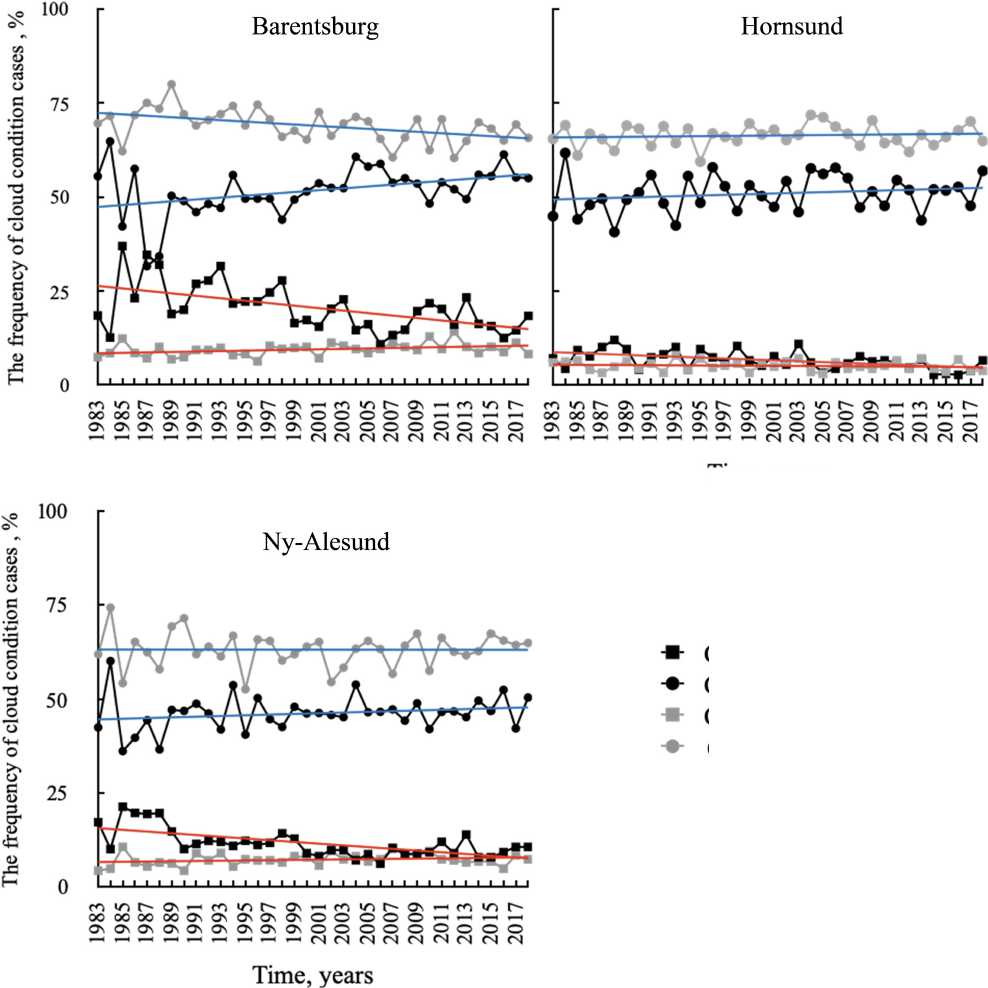
Time, years
Fig. 5. Inter-annual variability of annual average values of clear and cloudy sky frequency according to observations and ERA5
Clear sky station Cloudy sky station Clear sky ERA5 Cloudy sky
Regression slope and correlation coefficients
Table 3
|
Cloudy sky |
Clear sky |
||||
|
Regression slope (%/ decade) |
R2 |
Regression slope (%/ decade) |
R2 |
||
|
Barentsburg |
Observations |
2,5 |
0,15 |
-3,3 |
0,29 |
|
ERA5 |
-1,9 |
0,23 |
0,6 |
0,13 |
|
|
Hornsund |
Observations |
0,9 |
0,04 |
-1,2 |
0,26 |
|
ERA5 |
0,3 |
0,01 |
-0,18 |
0,02 |
|
|
Ny-Alesund |
Observations |
-0,02 |
0 |
-1,5 |
0,32 |
|
ERA5 |
0,05 |
0 |
0,2 |
0,02 |
|
The rate of decrease is 0,12% per year or ≈1,2% per decade. It has stronger relation and the correlation can be proven on the highest significance level p =0.01. The t-coefficient for sky condition mentioned is 2,93.
The opposite tendency is also shown for reanalysis data. ERA5 data trend is in accordance with in-situ data: slight increase of cloudy sky trend and decrease of clear sky trend. The rate of increase of cloudy sky conditions is 0,03%/year or 0,3%/decade what is three times less than the observations. The estimation of cloudy sky case trend revealed that the t-coefficient is 0,63 so that the correlation cannot be proven even on the lowest significance level. The rate of decrease of clear sky conditions is 0,018%/year or 0,18%/decade. The t-coefficient for clear sky condition is approximately 0,81. So that the results of Hornsund station are in better accordance with reanalysis data than for Barentsburg station. However, the correlation coefficients in both cases are not representative.
As for Ny-Alesund, the percentage of cloudy sky for station data does not show any change in time according to the trend line. The decrease (less than 0,01% per year) and the correlation coefficient (R=0) are not significant. The clear sky trend has a tendency to decrease — 0,15% per year or 1,5% per decade. The estimation of trend significance reveal that the t-coefficient is 5,05 which proof the correlation on the highest significance level.
The reanalysis data trend of cloudy sky cases is in accordance to in-situ data. Trend line for cloudy sky cases does not show any changes (the rate of increase is less than 0,01% per year and the correlation coefficient ≈0). However, the average value of cloudy sky cases is 1,5 times higher than station data. The comparison of clear sky cases shows mismatch of trends. Reanalysis data is considered to have insignificantly increasing trend while station trend line is appeared to decrease. ERA5 shows increase of clear sky trend which is 0,02%/year or approximately 0,2%/decade while observations give the decrease of the same sky condition and the rate of decrease is about 7 times higher than the velocity of increase of ERA5 data. The significance of clear sky case is 0,95. The correlation cannot be proven on the lowest significance level.
To sum up, the differences between stations data and reanalysis are estimated to be quite significant in all three cases (Barentsburg, Hornsund, Ny-Alesund). In case of cloudy sky, reanalysis data replicate stations tendencies on seasonal and inter-annual scales. In case of clear sky, the inequalities are more visible. The tendencies of clear sky cases in seasonal scale in all three stations have opposite relations between station data and reanalysis data. As for inter-annual scale, reanalysis data does not keep a tendency to decrease of clear sky values. Cloudy sky condition trends on inter-annual scale revealed to have not significant correlation in both observations and reanalysis data. Clear sky conditions are better correlated based on stations data; however, reanalysis does not provide the same level of correlation.
Conclusions
The study of monthly distribution of cloud cover on three meteorological stations revealed Hornsund which is the most southern station considered as the station with the highest amount of cloudy sky cases and, consequently, the lowest value of clear sky cases. In contrast, Barentsburg station is identified to have the lowest amount of cloudy sky cases for all seasons except winter. Ny-Alesund station is the most northern station considered but does not show the opposite results to Hornsund. The latitudinal character of clouds distribution is not defined.
The highest values of cloudy sky are revealed in summer season. The months with the highest amount of cloud are from July to September. The lowest values are considered in April for all stations. The comparison of monthly results of cloud cover of observations and reanalysis shows that the reanalysis overestimates the cloudy sky conditions for all three stations. Barentsburg is the station with the highest number of overestimation. June and August are the months with the concordance of reanalysis and field data in Ny-Alesund station. The summer season is appeared to be quite concordat, however, the other seasons show dramatic differences between observations and reanalysis. The highest level of concordance of cloudy sky is detected in Hornsund station. The results of comparison of reanalysis and field data for clear sky conditions are generally more consensual than the cloudy sky conditions. The differences between stations and reanalysis are approximately three times lower for clear sky conditions than for cloudy sky.
On inter-annual scale the comparison of stations data and reanalysis are also evaluated as inconsistent. The values of cloudy sky cases slightly increase for all three stations but the increase is not significant in Hornsund and Ny-Alesund. Reanalysis show the opposite trend for Barentsburg station (decreasing of cloudy sky cases) and overestimate the percentage of cloudy sky. For Hornsund and Ny-Alesund the tendency to slight insignificant increase continues, however, the overestimation is about 15% for both stations.
The clear sky conditions are better simulated on inter-annual variability. The reanalysis values are underestimated compare to observations. The Hornsund station is in the best accordance. The reanalysis underestimates the clear sky values only by 5%. In contrast, in Barentsburg station the underestimation of reanalysis is 10%.
Acknowledgements
Current study is done within the framework of the section 5.1.4 “Monitoring of the state and pollution of the environment including cryosphere in Arctic basin and research observatory « ice base Baranova cape» region, hydrometeorological observatory Tiksi and russian scientific center on Svalbard. This study would not have been possible without a support of such organizations as Saint Petersburg State University, Hamburg University, Federal Ministry of Education and Research, project “CATS synthesis: The Changing Arctic Transpolar System”, FKZ 03F0831A.
Список литературы Seasonal and annual variability of Svalbard cloud cover
- Meier, W.N., Hovelsrud, G.K., van Oort, B.E.H., Key, J.R., Kovacs, K.M., Michel, C., Haas, C., Granskog, M.A., Gerland, S., Perovich, D.K., Makshtas, A. and Reist, J.D. (2014) Arctic sea ice in transformation: a review of recent observed changes and impacts on biology and human activity. Reviews of Geophysics, 52(3), 185- 217.
- Francis, J. A., Vavrus, S. J. & Cohen, J. (2017) Amplified Arctic warming and mid-latitude weather: new perspectives on emerging connections. WIREs Clim. Chang. 8, e474.
- Fyfe, J. C., K. von Salzen, N. P. Gillett, V. K. Arora, G. M. Flato, and J. R. McConnell (2013), One hundred years of Arctic surface temperature variation due to anthropogenic influence, Sci. Rep., 3, 2645.
- Overland, J. E., and M. C. Serreze (2012), Advances in Arctic atmospheric research, in Arctic Climate Change: The ACSYS Decade and Beyond, edited by P. Lemke and H.-W. Jacobi, pp. 11- 26.
- Serreze, M. C., A. P. Barrett, and J. J. Cassano (2011), Circulation and surface controls on the lower tropospheric air temperature field of the Arctic, J. Geophys. Res., 116, D07104.
- Park, D.-S. R., S. Lee, and S. B. Feldstein (2015), Attribution of the recent winter sea ice decline over the Atlantic sector of the arctic ocean, J. Clim., 28(10), 4027- 4033.
- Isaksen, K., 0. Nordli, E. J. F0rland,E.Eupikasza, S. Eastwood, andT. Niedzwiedz(2016), Recent warmingon Spitsbergen—Influence of atmospheric circulation and sea ice cover, J. Geophys. Res. Atmos., 121,11,913-11,931.
- Kay, J.E. and L'Ecuyer, T. (2013) Observational constraints on Arctic Ocean clouds and radiative fluxes during the early 21st century. Journal of Geophysical Research: Atmospheres, 118(13), 7219- 7236.
- Curry, J., Rossow, W., Randall, D. and Schramm, J. (1996) Overview of arctic cloud and radiation characteristics. Journal of Climate, 9, no. 8, pp. 1731-1764.
- Liu, Y., Key, J. R., Frey, R. A., Ackerman, S. A. and Menzel, W. P. (2004) Nighttime polar cloud detection with MODIS. Remote Sensing of Environment, 92, no. 2, pp. 181-194.
- Chernokulsky, A.,Mokhov, I.,(2012) Climatology of Total Cloudiness in the Arctic: An Intercomparison of Observations and Reanalyses.Advances in Meteorology, 2012, 1-15.
- Chernokulsky, A., Esau, I. (2019) Cloud cover and cloud types in the Eurasian Arctic in 19362012. International Journal of Climatology, 39(15), 5771-5790.
- Graversen, R.G., Langen, P.L. and Mauritsen, T. (2014) Polar amplification in CCSM4: contributions from the lapse rate and surface albedo feedbacks. Journal of Climate, 27(12), 4433- 4450.
- Makshtas, A., Andreas, E.L., Svyashchennikov, P.N. andTimachev, V.F. (1999) Accounting for clouds in sea ice models. Atmospheric Research, 52, 77-113.
- Eastman, R., Warren, G. S. (2010) Arctic Cloud Changes from Surface and Satellite Observations. Journal of Climate, 23(15), 4233-4242.
- Maturilli, M., Ebell, K. (2018) Twenty-five years of cloud base height measurements by ceilometer in Ny-Álesund, Svalbard. Earth System Science Data, 10, 1451-1456.
- Demchev, D., Kulakov, M., Makshtas, A., Makhotina, I., Filchuk, K., Frolov, I. (2020) Verification of the data from ERA-Interim and ERA5 reanalyseson surface air temperature in Arctic. Meteorology and Hydrology, 11, 36-45. [in Russian]
- Naud, C. M., Booth, J. F., & Del Genio, A. D. (2014). Evaluation of ERA-Interim and MERRA Cloudiness in the Southern Ocean. Journal of Climate, 27(5), 2109-2124.
- Walsh, J. E., & Chapman, W. L. (1998). Arctic Cloud-Radiation-Temperature Associations in Observational Data and Atmospheric Reanalyses, Journal of Climate, 11(11), 3030-3045.
- Osuch, M., Wawrzyniak, T. (2017). Variations and changes in snow depth at meteorological stations Barentsburg and Hornsund (Spitsbergen). Annals of Glaciology, 58(75pt1), 11-20.
- Wawrzyniak, T. and Osuch, M. (2020): A 40-year High Arctic climatological dataset of the Polish Polar Station Hornsund (SW Spitsbergen, Svalbard), Earth Syst. Sci. Data, 12, 805-815.
- Wawrzyniak, T; Osuch, M (2019): A consistent High Arctic climatological dataset (1979-2018) of the Polish Polar Station Hornsund (SW Spitsbergen, Svalbard).
- Hersbach, H., Bell, B., Berrisford, P., Hirahara, S., Horányi, A., Muñoz Sabater, J., et al. (2020). The ERA5 global reanalysis, Quarterly Journal of the Royal Meteorological Society, 146, 1999- 2049.
- Montgomery, D. C., Peck, E. A., Vining, G. G. (2021) Introduction to linear regression analysis, sixth edition, 24-25.

